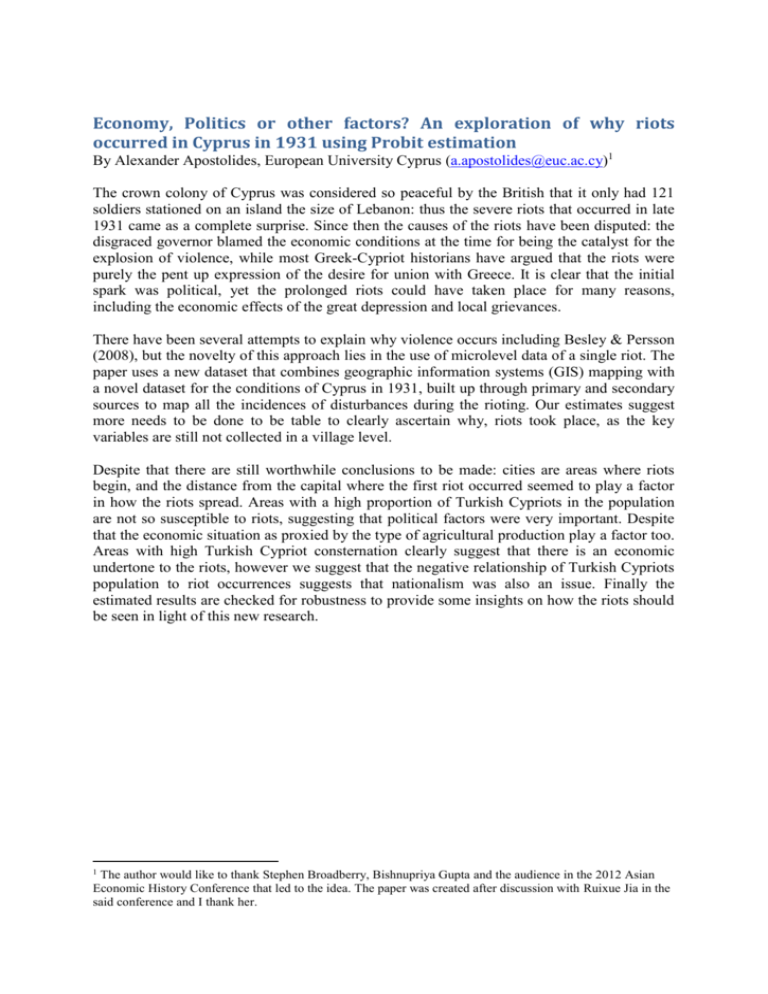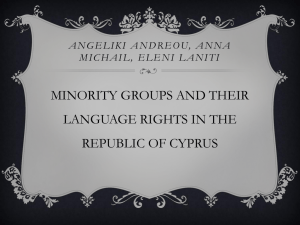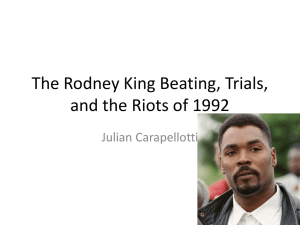Economy, Politics Or Other Factors? An Exploration Of Why Riots
advertisement

Economy, Politics or other factors? An exploration of why riots occurred in Cyprus in 1931 using Probit estimation By Alexander Apostolides, European University Cyprus (a.apostolides@euc.ac.cy)1 The crown colony of Cyprus was considered so peaceful by the British that it only had 121 soldiers stationed on an island the size of Lebanon: thus the severe riots that occurred in late 1931 came as a complete surprise. Since then the causes of the riots have been disputed: the disgraced governor blamed the economic conditions at the time for being the catalyst for the explosion of violence, while most Greek-Cypriot historians have argued that the riots were purely the pent up expression of the desire for union with Greece. It is clear that the initial spark was political, yet the prolonged riots could have taken place for many reasons, including the economic effects of the great depression and local grievances. There have been several attempts to explain why violence occurs including Besley & Persson (2008), but the novelty of this approach lies in the use of microlevel data of a single riot. The paper uses a new dataset that combines geographic information systems (GIS) mapping with a novel dataset for the conditions of Cyprus in 1931, built up through primary and secondary sources to map all the incidences of disturbances during the rioting. Our estimates suggest more needs to be done to be table to clearly ascertain why, riots took place, as the key variables are still not collected in a village level. Despite that there are still worthwhile conclusions to be made: cities are areas where riots begin, and the distance from the capital where the first riot occurred seemed to play a factor in how the riots spread. Areas with a high proportion of Turkish Cypriots in the population are not so susceptible to riots, suggesting that political factors were very important. Despite that the economic situation as proxied by the type of agricultural production play a factor too. Areas with high Turkish Cypriot consternation clearly suggest that there is an economic undertone to the riots, however we suggest that the negative relationship of Turkish Cypriots population to riot occurrences suggests that nationalism was also an issue. Finally the estimated results are checked for robustness to provide some insights on how the riots should be seen in light of this new research. 1 The author would like to thank Stephen Broadberry, Bishnupriya Gupta and the audience in the 2012 Asian Economic History Conference that led to the idea. The paper was created after discussion with Ruixue Jia in the said conference and I thank her. Introduction: What causes riots and peasant revolts? What causes riots? This is a question that has been looked by a wide range of social scientists and economists. Preconditions to revolutions and riots have been proposed as far back as Karl Marx, who considered that history is defined by a series of inevitable revolutions once the rapid change of a structure of society outpaced the existing governmental structure. A historical approach was suggested by Brinton (1938) who suggested that there are preconditions that are common throughout most revolutionary incidents, including discontent from all classes of a society, the lack of government support by a sufficiently large group of the population and a state that is close to bankruptcy. The determinants of riots and revolutions have come back in the public interest through the recent Arab spring, with commentators trying to pinpoint commonalities between the causes of the riots in different countries (Rodenbeck, 2013). Theoretical models on the incidence of violent revolt or civil war have been developed in economics (Grossman 1991). The link between an economic crisis and subsequent insurrections has been present in the work of social scientists and historians, and has prominent place in the attempts by economists to explain conflicts (Miguel, Satyanath, & Sergenti 2004), including economic incentives but also social factors. Yet there are issues in how can one use empirics to test the validity of the theory, when conflict and political violence are eminently exceptional events. As revolutions and riots are rare events, they are difficulties in empirically testing theories that model riots and disturbances. Quantitative research has tested several theories of political violence by combining violent events across time and/or space, often spanning different continents and several centuries. Yet this can be less than satisfactory if we accept “that attempts at revolution everywhere should not be mere imitations of previously successful upheavals but should, instead, be tailored to fit specific circumstances” (Blackey 1974; 191). Blackey’s suggestion presents a challenge to empirically testing causes of riots, civil wars and revolutions. If all revolutions have specific circumstances, then we might have serious statistical problems in testing economic theories on riots and disturbances: Some explanatory variables might important for some riots but less important to others, causing a variable to be considered as being less important than it really was. It could also be that there are variables that could explain the incidence of a disturbance but they are missing entirely from the databases that are available. There are ways to deal with such issues, but these methods require a substantial data or might involve categorising revolutions. As a result a researcher could be accused of cherry picking data or of expanding the dataset to include events that are very dissimilar in nature. However a different approach is to build detailed level information for each riot, civil war and revolution. A riot or a revolution is simply an aggregation of many events of disturbances across time: thus information on the series of events can be used to make detailed datasets that might test the predictive power of variables. This approach to riots can combine the empirical and theoretical work of economics with the work of historians who catalogue how riots take place. This approach might give better understanding to the dynamics of riots and revolutions, but it cannot estimate the importance of events that affected the whole population, such as tax increases. Thus a localised approach build up for each revolution and riot can highlight as well as hide causes of disturbances. Our research tried to build from the evidence of detailed data for one incident of riots: the Cypriot riot of 1931. In our case the research is focused on incidences of public disturbance that occurred in a two month period starting from the 21st of October 1931 in Cyprus. Cyprus was at that time a crown colony of the British Empire. The interwar period between the First and the Second World War show an unusual large number of disturbances in the British Empire, as the global economic instability of the period was combined with the growing nationalistic movements in the colonies. The integration of the colonies within the global economy prior to the establishment of Empire wide duties meant that colonial subjects invested in producing material used in a globalised scale were gravely affected during this period (Brown 1989). Significant riots and protests took place in India, Burma and British West Africa in the 1930s were issues of the collapse of primary product prices, the increase of taxation and a rural credit crunch led to violent confrontation (Rothermund, 1996) «Τα Οκτωβριανά»: The October 1931 riots and their significance Cyprus became a British protectorate of Britain in 1878. Under the Cyprus Convention the island remained nominally under Ottoman suzerainty but all power was transferred to the British High Commissioner (Hill 1952). The change did not lead to a rapid modernisation of the outdated administration system: despite some improvement of the judicial system and the introduction of a limited constitution; the emphasis of the British administration was in maintaining the status quo and not in transforming the Ottoman system (Georghallides, 1979). The subsequent occupation of Egypt removed the strategic purpose from the occupation of Cyprus, leaving “a lingering quality of being bereft, verging on pointlessness, which British rule there could never shake off” (Holland and Markides, 2008: 165). The island was annexed in 1914 with the start of hostilities towards the Ottoman Empire; resolution of its status as a crown colony only took place in 1925. This inaction was partly caused by the fiscal constraints of the colonial administration. Britain was supposed to provide an annual payment of £92,799 sterling to the Sultan in lieu of the lost tax revenue from Cyprus. The British administration raised most of the ‘tribute’ from taxation in Cyprus2. Yet the amount was in excess of the fiscal surplus of the colony, providing a large disincentive for change: any fiscal surplus was whisked off to the British Treasury as payment for the so called “Tribute” (Georghallides, 1985).After insistent protests the ‘tribute’ was partially reduced by a permanent grant-in-aid of £50,000 in 1907; yet £42,799 of the ‘tribute’ remained a burden to government expenditure until 1927, and still a payment of £10,000 for imperial defence was expected from 1928 onwards. The colony had a limited constitution which was revised but essentially remained unchanged when Cyprus became a crown colony in 1925. The Cypriot constitution, given in 1882, was advanced for the time: yet the lack of substantial modernisation with the declaration of the island as a crown colony made it look outdates when compared to the neighbouring crown colony, Malta. It was based on clear “divide and rule principles”: the colonial government had to appease either the majority Greek-Cypriot or the minority Turkish-Cypriot community in order to pass legislation and fiscal appropriation bills (i.e. the budget). As a result the legislative council heightened communal tensions that were already present on the island. For the Cypriots the constitution was ineffective as all power and influence remained with the colonial government: the legislative assembly could not create or even modify laws, as it could only pass or reject laws proposed by the Colonial executive. The executive could also circumvent the council by arranging for a law to be passed as an order-in-council by the British monarch3. 2 But the Ottoman government did not receive one penny as the British Treasury used the money to pay interest to the shareholders of the defaulted 1855 Ottoman loan, which it had guaranteed 3 The franchise for the legislative council was unusually wide, with the right to vote given to all men over 21 years old who paid their property tax which was set at low levels. This Legislative council constituted twelve elected members: six appointees of the High Commissioner, 3 elected Muslim representatives and 9 non Muslim representatives (based on the proportion of the 1881 census). The Greek and Turkish Cypriots elected exclusively by their own communities. Although the numbers were subsequently increased to twenty four with the declaration of Cyprus as a crown colony, the proportions, and thus the divisive nature of the council, remained unchanged. In the case of a tie, the governor, who was also the president of the legislative council, cast the deciding vote. Thus the government could overrule the wishes of the Greek-Cypriot majority as long as it could ensure that the TurkishCypriot minority voted in line with the colonial officials. The constitution provided the Cypriots with a council that could only be effective if the communities were united in their opposition to the government, and even then they could only force colonial government to listen, but not to comply, with their opinion. Prior to the First World War the colonial government effectively overruled the council, since the elected Turkish-Cypriot councillors consistently voted with the government. This was in part due to the fear of the fate of the community in the event that the Greek-Cypriots achieved Enosis (as union with Greece was known). The government ensured the loyalty of the Turkish-Cypriots councillors through the use of substantial government patronage that was bestowed on them4 (Holland and Markides, 2008). The immediate cause of the riots is related to the action of Legislative Council (henceforth LC) members. The Governor of Cyprus of the time, Sir Ronald Storrs, has ensured that Cyprus was not liable for the Cyprus Tribute back in 1926; yet he intentionally failed to inform the LC a provision to the British Treasury agreeing to stop billing the Cyprus government to the tune of £92,799 only if the colony reneged the rights to the amounts accumulated up to that time. By the middle of 1931, as Table 1 indicates, the Cyprus economy was suffering a severe recession. The recession combined the dramatic decline in agricultural and mining products due to the great depression with the worst drought in Cyprus since records began 4 For example, Ifran Bay was a member of the executive and the legislative council, as well as the Turkish delegate of the Evcaf which administered Muslim religious property (and effectively a government appointee). Thus his ability to exert substantial patronage over the Turkish-Cypriot community depended on maintaining the favour of the colonial administration. (Apostolides, 2010). The government deficit as a proportion to GDP was a modest but unprecedented -1.4%. Yet as the Cypriot economy was not able to accumulate substantial reserves due to the fiscal drain of the “Tribute” to the British treasury, the small reserve of £70,000 that the colony maintained was wiped out by the start of 1931. The government attempted to maintain wages at the same level in order to retain the services of British personnel: yet this was against the wishes of both communities in the council, who wished to see more high ranking Cypriots, which would be a natural consequence of a reduction in the wages of British colonial officials in Cyprus. How this affects Cyprus is mentioned in more detail elsewhere (Apostolides, 2012). Suffice to say here that the LC rejected laws to increase taxation as well as the government appropriation bill through an unprecedented and relatively consistent co-operation of a Turkish Cypriot representative and of the Greek Cypriot community, therefore overruling the government. The fact that the government was not able to pass the government budget or the additional taxation it requested (11 rises in the span of Ronald Storrs’s governorship, lasting under six years) did not lead to the government acquiescing to the demands of the LC; it chose to ignore the LC by passing laws and government budgets through orders-in-council. The resulting snubbing of the LC, combined with the worsening economic situation (see table 2) made the conditions explosive Table 1A: Cypriot GDP, Population, Per capita GDP, Government Revenue and Expenditure in constant 1938 Cyprus pounds5 Year GDP Population Per capita GDP 1921 1922 1923 1924 1925 1926 1927 1928 1929 £3,732,544 £4,001,854 £4,125,691 £4,029,952 £4,342,975 £4,169,484 £4,678,897 £4,574,781 £5,189,706 310,715 314,253 317,830 321,449 325,109 328,810 332,554 336,340 340,169 £12.01 £12.73 £12.98 £12.54 £13.36 £12.68 £14.07 £13.60 £15.26 Government Revenue Government Expenditure Budget Deficit / Surplus Year GDP £418,112 £471,461 £424,504 £435,785 £489,381 £444,797 £455,657 £507,504 £637,223 £415,599 £393,196 £435,959 £393,591 £453,850 £463,148 £427,200 £483,490 £602,063 £2,513 £78,265 £-11,455 £42,194 £35,531 £-18,351 £28,456 £24,014 £35,160 1930 1931 1932 1933 1934 1935 1936 1937 1938 4,911,844 4,605,234 4,213,399 4,232,438 4,755,859 5,318,422 5,237,377 6,226,713 6,544,460 Population Per capita GDP Government Revenue Government Expenditure Budget Deficit/ Surplus 344,042 347,959 353,982 360,109 366,342 372,683 379,134 385,697 392,373 £14.28 £13.23 £11.90 £11.75 £12.98 £14.27 £13.81 £16.14 £16.68 £677,372 £727,766 £761,123 £748,102 £776,723 £899,557 £824,552 £956,656 £1,023,230 £747,559 £742,164 £748,050 £698,357 £722,396 £853,725 £760,560 £835,170 £908,024 £-70,187 £-14,397 £13,073 £49,745 £54,327 £45,832 £63,992 £121,487 £115,206 Table 1B: Growth rate of Cypriot GDP, Per capita GDP, Government Revenue and Expenditure Per Per capita Government Government capita Government Government GDP GDP Revenue Expenditure GDP GDP Revenue Expenditure Year Year 7.2% 6.0% 12.8% -5.4% -6.2% -7.3% 7.4% -0.7% 1921-1922 1930-1931 3.1% 1.9% -10.0% 10.9% -8.5% -10.1% 4.6% 0.8% 1922-1923 1931-1932 -2.3% -3.4% 2.7% -9.7% 0.5% -1.3% -1.7% -6.6% 1923-1924 1932-1933 7.8% 6.6% 12.3% 15.3% 12.4% 10.5% 3.8% 3.4% 1924-1925 1933-1934 -4.0% -5.1% -9.1% 2.0% 11.8% 9.9% 15.8% 18.2% 1925-1926 1934-1935 12.2% 11.0% 2.4% -7.8% -1.5% -3.2% -8.3% -10.9% 1926-1927 1935-1936 -2.2% -3.3% 11.4% 13.2% 18.9% 16.9% 16.0% 9.8% 1927-1928 1936-1937 13.4% 12.2% 25.6% 24.5% 5.1% 3.3% 7.0% 8.7% 1928-1929 1937-1938 -5.4% -6.4% 6.3% 24.2% 1929-1930 1926-1931 2.0% 0.9% 10.3% 9.9% Note: Deflated using the CPI provided in appendix H of Apostolides, A. (2010) Source: Cyprus, Statistical (Blue) Books, (1921-1938) “Government Revenue and Expenditure” 5 Apostolides, A. (2010) “Economic Growth or Continuing Stagnation? Estimating the GDP of Cyprus and Malta, 1921-1938”, London School of Economics Theses, Table 2: Real GDP decline in Cyprus compared to other countries in constant prices (Index; 1929=100) Western Europe (30 Countries) Germany Greece USA UK Cyprus Malta 1929 1930 1931 1932 100 100 100 100 100 100 100 98 98 96 90 99 95 99 92 90 91 82 93 89 101 89 83 98 71 94 81 104 Source: Apostolides 2010; Maddison 2010 In fact the economic situation of Cyprus was affecting the majority rural population (78% of the population according to the 1931 census). Cypriot communities (majority Greek/Christian and minority Turkish/Moslem) were overwhelmingly resident in rural areas and working in the primary sector6. They were also scattered geographically in a mosaic of communities; thus the effect of the combined depression and drought affected both communities relatively similarly. The depression of Cyprus might have affected the different minorities in a similar way, but it does not affect all geographical areas equally. Agricultural production in Cyprus is very structured due to environmental conditions. The presence or not of height and water delineated what the villagers could or could not produce. As table 3 shows different types of agricultural production: crops dependent on rainfall such as grain, carobs and olives were much more seriously affected that those areas where aquifers were based on irrigation. Table 3: Real value added of agricultural production in Cyprus (Index; 1929=100) 1929 1930 1931 1932 Ag., For & Fish 100 99 88 80 Annual Crops 100 90 70 48 Perennial Crops Animal Production 100 114 105 86 100 99 102 100 Farm Ancillary 100 100 82 117 Source: Apostolides 2010 6 Also it is true that Turkish Cypriots did have modest overrepresentation relative to their population in urban centres The downturn in agricultural production led a credit crunch in the informal credit system. Cyprus farmers were burdened with debt they could not repay, which was similar situation as in other East Mediterranean states; the combined drought and depression rapidly increased the amount of non-performing loans, as indicated by the increase in forced sales of mortgaged rural property. Despite the rapid growth of the cooperative saving banks prior to the great depression, the faulty structure of the sector ensured that the cooperatives could not provide relief, leading to a serious retrenchment of the available rural credit markets (Apostolides, Vrachimis, Vostis, 2013) By late 1931 the situation was worsening both politically and economically volatile. The government reserve was exhausted and the government refused to even discuss the demand by the LC to dramatically cut the wages of British officials to level desired by the Cypriots. Instead it passed substantial increases in duties and excise, increasing taxation both in luxury and in staple consumption goods (the government monopoly on salt was particularly hated). The British Colonial office considered that the increases were not enough to ensure the island would not need to be bailed out by a “grant-in-aid” by the British government and it was delaying the confirmation of the Order-in-Council that would pass the government budget and tax increases. This severely weakened the bargaining hand of the Governor, who could not pass any legislation by the LC unless the grievances were acted upon, but he could not count on the Colonial office accepting that there would not be additional taxation demands in 1932. To add to the volatile situation the secret deal of the Governor with the British treasury when the “Tribute” was abolished was made public on the 8th of July 1931. In response to a question in the British Parliament, the Chancellor confirmed that the Governor of Cyprus waived the right of the surplus accumulated by the “Tribute”, an amount that was up to 50% of Cypriot GDP. This led to the Greek Cypriot members of the LC, under pressure from more nationalistic elements in the community, to try and form a communal response against the upcoming vote for the budget for 1932. Yet the response would have to go beyond rejection of the government demands in the LC as the body was effectively sidelined thorough direct rule from London through the King’s “orders-in-council”. The demands for tax strike or even more bold actions were resisted throughout September by one of the major forces of the Greek Cypriot community and the leading LC member, The metropolitan bishop of Larnaca, Nicodemos Mylonas. Yet on the 17th of October, Nicodemos Mylonas surprised all by resigning his seat on the LC; his proclamation called for passive resistance against the British, with the sole aim to achieve Cyprus union with Greece. On the 19th N.K. Lanitis also resigned his seat at the LC after a meeting of the Greek Cypriot community leaders in the 18th ended with no decision on the future course of action. By the 21st a march calling for Union with Greece in the capital, Nicosia, led to the Governor’s palace being burned down and the first dead among the Cypriot rioters. News of the casualties spread and soon they were disturbances across the island. The riots occurred in cities, but also across the rural area. The following map indicates just how extensive the riots and disturbances were: in fact the primary sources collected by this study indicate that the police commissioner intentionally underplayed the extent of the riot (and of casualties) by suggesting that acts of disturbances were filed under other criminal offenses (such as arson or theft). Image 1: Map of Cyprus with the reported disturbances during October 1931 Note: the colour determines the amount of disturbances in that location: Once disturbance –Green, Two – Blue, Three – Purple, Five – Red. The disturbances were quelled by the 2nd of November by the rapid re-enforcement of the British Garrison by sea and by air7. The governor suspended the constitution and declared that the Greek Cypriot community was to blame and placed a punitive tax (The Reparation Impost Law) to the community of £34,315. Why is the 1931 riot important in Cyprus historiography? The 1931 riot is important not just for the dynamic repercussions in the relationship of GreekCypriots and the British. Its causes have been disputed. The main disputes are whether the riots were driven or spontaneous, and whether they were largely due to economic or political issues. The official report of the riots thought the riots as being fanned by the Greek Cypriot political elite8. The official colonial office position as expressed in parliament was that the Cypriot church launched the disturbances for political and the merchants who were going to be affected by the increase in duties supported it to avoid the tax increases. In fact the report constantly argues that the disturbance was driven by members of the establishment egging different areas on by travelling to villages from Nicosia after the initial riot and the burning of the Governor’s palace took place. On the other hand the Cypriot historians who looked at the riots in detail (Georghallides, 1985, Papapoliviou et al, 2004, Stylianos 1984) insist the riots were a spontaneous outbreak of grievances. The causes of the riots are also in dispute the colonial government insisted that they were entirely due to the economic distress of the population, caused by the global trade conditions. Greek-Cypriot historians argue that the riots were motivated by nationalistic sentiment, since their immediate cause were protests for union with Greece. Thus there is a debate on whether the violence in October 1931 was motivated by economic frustration or nationalistic sentiment. 7 The provision of reinforcements by air from Egypt is perhaps the first such air action in the world and shows how seriously the situation was considered to have been by the Colonial Office at the time 8 For a description of the events in 1931: Command 4045, “Disturbances in Cyprus in October 1931” British Parliamentary Papers. Reports from Commissioners, Inspectors and Others: vol.VI session 03/11/1931 to 17/11/1931 pp.504–544 The paper is an attempt to shed light on both issues by the use of quantitative techniques. It will attempt to answer the following question: Can we predict which villages rioted in 1931 based on economic and social characteristics? Data and Methodology A new dataset of all incidences of disturbances was created. Primary sources were used. The report of disturbances noted extensive incidences, yet curiously the report suggests over 200 villages took part in act of defiance to the regime. However the reported incidences are much less in number, suggesting that many acts of defiance we not added to the official list of disturbances as sent to the British Parliament. Papapoliviou et al, (2004) had an appendix of primary sources collected from the police report of the year that were collected though extensive research in the Cyprus Archives. They indicate a much more extensive incidence of disturbances and they have been integrated into the database along with the official report. In addition Stylianou (1984) used extensive first hand information that was cross checked with Greek and Cypriot archival resources to increase the number of disturbances that were represented. To add to the above dataset the previously unpublished diaries of convicted ringleaders (Galatoupoulos, 2011, Sofokleous 2003) have been used to both cross check and improve the list of disturbances that took place in Cyprus. What is defined as a disturbance? A disturbance could be an attempt to burn down government building (in Drousia) from a mass demonstration (in Lefkara) to stealing of weapons from police stations (in Dhikomo). We found 151 incidences in disturbances during that brief one month period. These were placed on a map according to where the incident was recorded using ARCgis: there was enough information to accurately place 143 of the incidences in the communities on the map reproduced here. This is still short from the comment in the official report of 200 villages (out of roughly 663) rising up. It is fortunate that the same year but before the disturbances (in April) there was a island wide census. The Cypriot censuses are considered particularly reliable (Veropoulou, 1997) and thus provide with accurate village by village information. The census includes information on population (Moslem and Greek), the arable land and the number of Vine-yards, Vegetable Gardens, Carob trees, Olive trees and fruit trees. In addition the colonial blue book provides information on all the villages that established a cooperative credit society, the year of establishment the number of members, the size of the initial capital and whether it receive funds from the recently established (and by 1931 moribund) government Agricultural bank. The biggest innovation is using maps to establish the land use of the village administration. Using a cadastral survey of the 1960, we could map the land use and match it to the village. Two weaknesses remain with this approach however: 1) There is a difference in the amount of land under irrigation in 1960 from 1931. A rough rough map of 1927 can be used to correct this, as well as the recorded area under irrigation reported in the 1961 and 1931 census. They are not very sever, but they are present. However the underlying map is not digitised, meaning alterations cannot take place. We have recently acquired the land use map in digital ARCgis form of 2000 and we are working on replacing and then correcting the map of 2000 to bring it back to 1931 conditions. 2) As the underlying map is not digitised we cannot yet establish coefficient of land us of a village that takes into account the whole are under municipal boundaries. Thus land use is for now determined as the land use as represented by the actual village settlement, rather than the village boundaries. This means that for villages were we could not determine a single land use pattern on its settlement point were excluded, dropping our sample from 651 to 550. This is the major weakness of the above attempt and it is being overcome by the use of a digital map. Image 2: Disturbances in 1931 with Land Use map of 1960. We would have liked to have other village based data. The parliamentary report accuses the middle class of churchmen, lawyers and teachers of leading the riots. The census gives account of the number of lawyers and teachers, but the final report gives the evidence in a district and not village level data. It is hoped that the original census returns will be found in the archive, yet the chances of them surviving are slim. As the tax increase the government was proposing was affecting items of staple consumption, data on village consumption would be ideal. Consumption data were also collected in a census of rural living conditions that was taken in 1927; yet again the final report does not report detailed consumption data. Riots are a discrete dependent variable. In this case although it is not binary (i.e. 0 or 1) a binary model is used. This is because all cities rioted (and they did so more than once) meaning it loses explanatory power and drops out of the regression, and hence that leaves only 16 villages where there was more than one disturbance. Thus the dependent variable was normalised to 0 – no riots, and 1 – riots. The regression analysis presented here is the first step in the process of analyzing the existing database. A logit regression is attempted where the depended variable (did a riot occur in October 1931) is explained by the independent variables: Distance from Nicosia (in Km), the percentage of Greek Cyprus to the population, the size of the village as represented by the population and the agricultural land use pattern of the village settlement. The results are shown below: Despite some disappointment the above has some encouraging and interesting signs. It clearly shows that the existing land use determination of the village settlement is problematic; if the variable is going to have any meaningful predictive power the land use of the village region needs to be accounted for. Yet at the same time it shows positives. It confirms that the more homogenous the villages of Greek-Cypriots Greek Cypriot villages were much more susceptible to disturbances, making the political a stronger predictor than economic factors. It is surprising that Co-operatives seem to have been established in areas of distress, and the distance from the source of the initial riot is weaker than what the historical literature would suggest. Bibliography Apostolides, Alexander, Vrachimis Konstantinos, Votsis, Chirstos, (2013) “We have been here before?” Tracing the evolution of the Cypriot cooperative movement through crises. “ International Cooperative Alliance Research Conference, 13th of June, European University Cyprus Apostolides Alexander (2012) debt, large problems in Cyprus: How even small debt in a British Colony led to the political crisis and violence in October 1931, Asian Economic History Conference, 13th of September 2012, Hitotsubashi University, Apostolides, Alexander (2010) Economic growth or continuing stagnation? Estimating the GDP of Cyprus and Malta, 1921-1938. PhD thesis, The London School of economics and Political Science (LSE) Besley, Timothy J.& Persson, Torsten (2008) “The Incidence of Civil War: Theory and Evidence”, NBER Working Paper No. 14585 Brinton Crane, (1938 republished 1965) The anatomy of Revolution (Prentice Hall) British parliamentary papers: Command 4045, “Disturbances in Cyprus in October 1931” Reports from Commissioners, Inspectors and Others: vol.VI session 03/11/1931 to 17/11/1931 pp.504 – 544 Blackey, Robert, (1974) “Fanon and Cabral: A Contrast in Theories of Revolution in Africa” The Journal of Modern African Studies, 12(1) pp.191-209 Brown, I., The Economies of Africa and Asia in the inter-war depression (Padstow: T.J. Press, 1989) Galatopoulos (1934, printed 2011) [Translated From Greek] In the fires of the Governor’s Palace: The previously Unpublished diary of Christodoulos Galatopoulos (Nicosia, Epifaniou Press) Georghallides, G.S., A Political and Administrative History of Cyprus 1918-1926, (Nicosia: Zavallis Press, 1979) Georghallides, G.S., Cyprus and the Governorship of Sir Ronald Storrs: The Causes of the 1931 Crisis, (Nicosia: Cyprus Research Centre, 1985) Grossman, Herschel (1991) “A General Equilibrium Model of Insurrection,” American Economic Review 81, 912-921 Hill, G., A History of Cyprus: Volume IV (Cambridge: Cambridge University Press, 1952) Holland, R. & Markides D., The British and the Hellenes: Struggles for Mastery in the Eastern Mediterranean 1850-1960, (Oxford: Oxford University Press, 2008) Maddison, A., (2010) Statistics on World Population, GDP and Per Capita GDP, 1-2006 AD, http://www.ggdc.net/maddison/ Miguel, Edward, Satyanath, Shanker, and Ernest Sergenti (2004), “Economic Shocks and Civil Conflict: An Instrumental Variables Approach”, Journal of Political Economy 112, 725-753. Papapoliviou, P, Livadas, V, Spanos, G, (2004) [Translated from Greek] The insurrection of October 1931 (Nicosia: Imprinta Press) Rodenbeck, Max (2013) “A climate of change”, The Economist, Special Report- The Arab Spring July 13th Rothermund. D., The Global impact of the great depression 1929-1933 (New York: Routledge, 1996) Stylianos, Petros, (1984; printed 2003) [Translated from Greek] The October riots and the revolt of 1931 in Cyprus (Nicosia: Epifaniou Press)








